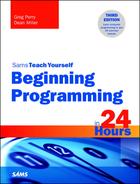Introduction
Learning how to program computers is easier than you might think. If you approach computers with hesitation, if you cannot even spell PC, if you have tried your best to avoid the subject altogether but can do so no longer, the book you now hold contains support that you can depend on in troubled computing times.
This 24-hour tutorial does more than explain programming. This tutorial does more than describe the difference between JavaScript, C++, and Java. This tutorial does more than teach you what programming is all about. This tutorial is a training tool that you can use to develop proper programming skills. The aim of this text is to introduce you to programming using professionally recognized principles, while keeping things simple at the same time. It is not this text’s singular goal to teach you a programming language (although you will be writing programs before you finish it). This text’s goal is to give you the foundation to become the best programmer you can be.
These 24 one-hour lessons delve into proper program design principles. You’ll not only learn how to program, but also how to prepare for programming. This tutorial also teaches you how companies program and explains what you have to do to become a needed resource in a programming position. You’ll learn about various programming job titles and what to expect if you want to write programs for others. You’ll explore many issues related to online computing and learn how to address the needs of the online programming community.
Who Should Use This Book?
The title of this book says it all. If you have never programmed a computer, if you don’t even like them at all, or if updating the operating system of your phone throws you into fits, take three sighs of relief! This text was written for you so that, within 24 hours, you will understand the nature of computer programs and you will have written programs.
This book is aimed at three different groups of people:
![]() Individuals who know nothing about programming but who want to know what programming is all about.
Individuals who know nothing about programming but who want to know what programming is all about.
![]() Companies that want to train nonprogramming computer users for programming careers.
Companies that want to train nonprogramming computer users for programming careers.
![]() Schools—both for introductory language classes and for systems analysis and design classes—that want to promote good coding design and style and that want to offer an overview of the life of a programmer.
Schools—both for introductory language classes and for systems analysis and design classes—that want to promote good coding design and style and that want to offer an overview of the life of a programmer.
Readers who seem tired of the plethora of quick-fix computer titles cluttering today’s shelves will find a welcome reprieve here. The book you now hold talks to newcomers about programming without talking down to them.
What This Book Will Do for You
In the next 24 hours, you will learn something about almost every aspect of programming. The following topics are discussed in depth throughout this 24-hour tutorial:
![]() The hardware and software related to programming
The hardware and software related to programming
![]() The history of programming
The history of programming
![]() Programming languages
Programming languages
![]() The business of programming
The business of programming
![]() Programming jobs
Programming jobs
![]() Program design
Program design
![]() Internet programming
Internet programming
![]() The future of programming
The future of programming
Can This Book Really Teach Programming in 24 Hours?
In a word, yes. You can master each chapter in one hour or less. (By the way, chapters are referred to as “hours” or “lessons” in the rest of this book.) The material is balanced with mountains of shortcuts and methods that will make your hours productive and hone your programming skills more and more with each hour. Although some chapters are longer than others, many of the shorter chapters cover more detailed or more difficult issues than the shorter ones. A true attempt was made to make each hour learnable in an hour. Exercises at the end of each hour will provide feedback about the skills you learned.
Conventions Used in This Book
This book uses several common conventions to help teach programming topics. Here is a summary of those typographical conventions:
![]() Commands and computer output appear in a special
Commands and computer output appear in a special monospaced computer font. Sometimes a line of code will be too long to fit on one line in this book. The code continuation symbol (![]() ) indicates that the line continues.
) indicates that the line continues.
![]() Words you type also appear in the
Words you type also appear in the monospaced computer font.
![]() If a task requires you to select from a menu, the book separates menu commands with a comma. Therefore, this book uses File, Save As to select the Save As option from the File menu.
If a task requires you to select from a menu, the book separates menu commands with a comma. Therefore, this book uses File, Save As to select the Save As option from the File menu.
In addition to typographical conventions, the following special elements are included to set off different types of information to make it easily recognizable.
Note
Special notes augment the material you read in each hour. These notes clarify concepts and procedures.
Tip
You’ll find numerous tips that offer shortcuts and solutions to common problems.
Caution
The cautions warn you about pitfalls. Reading them will save you time and trouble.
